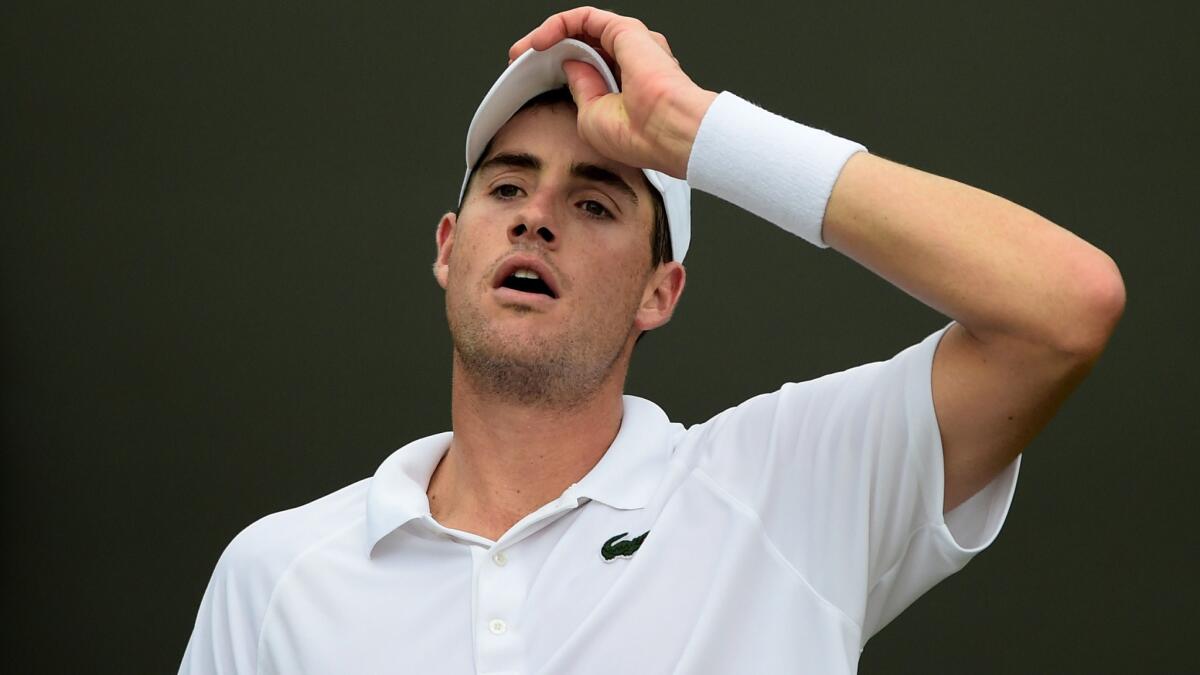Column: The plight of U.S. tennis: too much money and mollycoddling?

Sunday was a day of rest and reflection at Wimbledon. So we reflected.
Eyes squinting, brow furrowed, chin resting in palm of hand, we pondered the issue: How good are our tennis players from the United States?
Lousy.
It was a short reflection.
Monday will be a big day here for U.S. tennis, that former juggernaut still funded nicely by the mothership U.S. Tennis Assn., but listing badly to starboard for much of the last decade. Monday, John Isner and Madison Keys play in the second week of Wimbledon.
Ring the cowbells.
Yes, that’s all. Two players. Twenty-one from the U.S. started (13 women, eight men) and 19 have departed with congratulatory handshakes at the net — to the other player.
This could have been worse. Both Isner and Keys were scheduled to play Saturday, but rain pushed their third-round matches into the second week. We could have been like an entire country facing Clayton Kershaw. Blanked, shut out, zeroed.
Keys is a promising 19-year-old from Boca Raton, Fla., who has a nice future and lots of seasoned, grizzled seeded players in her path ahead here. Don’t expect to spend any Breakfast at Wimbledon time watching her next weekend. That sort of expectation would not be fair.
Isner, well, that’s a different story.
He is seeded No. 9 here, is 29 years old, graduated from Georgia before starting his pro career for real, and has the tools to play successfully with the big boys, which he has done on occasion. The best tool is his height. He is 6 feet 10, and trying to return his serve, especially on a grass surface, is like trying to catch a bullet in your teeth.
Sadly, players with names such as Federer, Djokovic, Nadal and Murray have caught the bullet quite well over the years and sent it back easily. Isner has played in 24 Grand Slam tournaments and produced one quarterfinal appearance, at the 2011 U.S. Open.
His Monday opponent is a dangerous 19th seed, Feliciano Lopez of Spain. After that, for Isner to proceed to some weekend Wimbledon action, he would have to wade through, most likely, Stan Wawrinka, then Roger Federer, then Rafael Nadal and finally on to Novak Djokovic or Andy Murray. A total of 40 major titles there.
That’s a tall order, even for the tallest of players.
The issue, of course, can’t just be strapped to the backs of a 19-year-old newcomer and a 29-year-old underachiever.
It is an issue of national shortfall, in a country that has magnificent resources for a sport that used to offer a buffet of delight from the Pete Sampras-Andre Agassi era, the Jimmy Connors-John McEnroe era, the Arthur Ashe-Stan Smith era, or back to Chris Evert and Martina Navratilova (a naturalized U.S. citizen), Tracy Austin and Pam Shriver, Lindsay Davenport and Jennifer Capriati.
Try as it might, the USTA and U.S. tennis fans cannot live forever in the glow of the Williams sisters and the Bryan brothers, especially since sibling twilight seems to be looming.
This is a complicated problem for U.S. tennis fans, because blaming a fat-and-happy national federation (USTA) for producing mostly fat-and-happy players is a bit simplistic. That’s why it was so interesting to see here this week that the Brits, and their equally fat-and-happy leadership (All England Lawn Tennis Assn.), are also under fire.
All Great Britain has left in the Wimbledon draw is Murray. It is not lost on people here that he not only is from Scotland, but got to his current star status in the sport without much aid from the Lawn Tennis Assn.
Like the questions that arise over the apparent ineffectiveness of all that money the USTA is spending on player development, the same questions arise here.
Solutions are complicated and blame comes easily. But there seems to be a common thread on both sides of the Pond. In March, Jose Higueras, No. 2 man in USTA Player Development, fired a shot across the bow when he said, during the Indian Wells tournament, “When a high percentage of the coaches want it more than the players, we have a problem.”
This week, no less than Murray’s mother Judy, the British Fed Cup captain, told the Guardian newspaper, “Our kids live in a comfort zone. I’d go back to basics and away from the mollycoddling and enormous expenditure. Let’s see who really wants it.”
Austin and Davenport, both broadcasters here, both in the Tennis Hall of Fame, and representing five major titles, echoed that.
“It’s the old fire-in-the-belly thing,” Austin said.
Davenport said, “You can’t teach a kid to want it.”
Clearly, an abundance of players from Eastern Europe want it and probably need it more than our kids and those of our British brethren.
Maybe all this is more generational than organizational. And that’s OK, since this isn’t about curing cancer or creating world peace.
There will always be great tennis players. Where they come from might merely be a roll of the dice. But Judy Murray is onto something.
Look to future tennis greatness coming from non-mollycoddling countries.
More to Read
Get our high school sports newsletter
Prep Rally is devoted to the SoCal high school sports experience, bringing you scores, stories and a behind-the-scenes look at what makes prep sports so popular.
You may occasionally receive promotional content from the Los Angeles Times.







